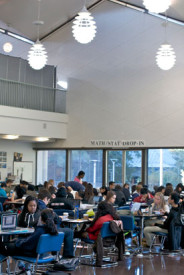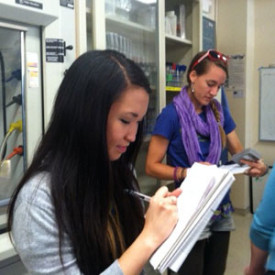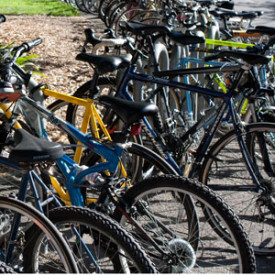Two years early, UC Berkeley meets its carbon-reduction target
A pledge made by UC Berkeley in 2007 to reduce its carbon footprint to 1990 levels has been met two years early. The achievement also puts the campus eight years ahead of meeting state and UC policies that call for reducing greenhouse-gas emissions to 1990 levels by 2020.

November 12, 2013
Two years ahead of schedule, a pledge made by UC Berkeley to reduce its carbon footprint to 1990 levels has been met, campus officials announced today (Tuesday, Nov. 12).
The achievement also puts UC Berkeley eight years ahead of meeting the University of California Sustainable Practices Policy guidelines and of observing the state’s Global Solutions Warming Act of 2006. Both call for the reduction of greenhouse-gas emissions to 1990 levels by 2020.
UC Berkeley sustainability leaders said greenhouse-gas emissions were reduced by:
- Investing in energy efficiency and sustainable transportation practices. Since 2006, the campus has saved 20 million kWh of electricity through building retrofits and reduced fuel use by more than 1 million gallons by increasing the number of bicycle, pedestrian and mass-transit commuters.
- Buying greener power. The campus is using electricity that includes more solar and wind energy and less coal through purchases from Pacific Gas & Electric, a utility that is required by state law to provide power that by 2020 will include 33 percent renewable energy.
- Improving data and methods. UC Berkeley has improved the accuracy of its emissions inventory profile by using the best data available about campus energy use and by staying current with the best reporting methods.
Chancellor Nicholas Dirks praised the Cal Climate Action Partnership (CalCAP), a coalition of faculty, campus leaders, staff and students that formed in 2006 to reduce greenhouse-gas emissions on campus, as well as its steering committee and the campus’s Office of Sustainability, for guiding this accomplishment.
He also vowed to set a new target in spring 2014 for further reduction of campus carbon emissions by 2020.
“Working in concert with CalCAP, my intention is to establish a new target that will take us further below 1990 levels,” said Dirks. “That will establish a challenging, but achievable, goal for the year 2020, on our path to climate neutrality for the entire campus. The fact that we already have exceeded state goals underscores UC Berkeley’s position as a leader in setting and implementing ambitious carbon-reduction strategies.”
“Climate change is an existential global threat,” he added, “and one that the UC Berkeley community is continually addressing through campus practices, teaching, research and public service.”
The current target was announced in April 2007 by former Chancellor Robert Birgeneau, who committed UC Berkeley to reducing its greenhouse-gas emissions by about one-third by 2014. That target was reached early based on data about campus emissions from 2012, the most recent year for which an annual emissions analysis was completed. The campus Office of Sustainability does the analysis; it then is verified by a third party.
Greenhouse gases are compounds, most notably carbon dioxide, that can absorb infrared radiation and thereby trap and hold heat in the atmosphere. The burning of fossil fuels is accelerating the release of these gases, which drives global warming and climate change.
A campus partnership
Kira Stoll, UC Berkeley’s sustainability manager, said the campus could not have set such an aspirational goal without its own faculty experts in the fields of climate science, policy, transportation, design and engineering. These faculty members shared the latest climate research findings and government initiatives with CalCAP, helping to achieve this milestone.
Undergraduate and graduate students’ creative initiatives and research also contribute to campus carbon-cutting solutions, she said. The student-run Berkeley Energy Resources Collaborative hosts an annual energy symposium addressing current and pressing issues that attracts hundreds of participants and renowned expert speakers. Since 2005, student interns with the PowerSave Campus program have held annual Blackout Battles. These energy-saving competitions between residence halls typically save the campus 130,000 kWh over two months.
“Student CalCAP research has helped us better understand the full scope of our emissions — from evaluation of the carbon associated with our purchasing to projecting how much carbon we would be responsible for 40 years from now if we don’t curb it,” said Stoll. “They’ve also made recommendations on a renewable energy mix for the campus and explored deeper energy efficiency measures.”
“Being at the world’s top public research university is one thing, but doing research as a student to help it reduce its carbon footprint is really an honor. Berkeley is becoming a model for carbon reductions, and not just in higher education,” said Autumn Petros Good, a Ph.D. student in the UC Berkeley Energy and Resources Group and a member of the CalCAP steering committee.
Greener buildings
With about 80 percent of campus carbon emissions associated with its buildings, especially its labs, setting a target “helped us usher in a new era in how we manage, renovate and construct our buildings with energy use in mind,” said Lisa McNeilly, UC Berkeley director of sustainability.
Over the last decade, campus leaders have launched funding strategies like the Strategic Energy Plan and the Operational Excellence Energy Management Initiative to provide resources to staff across campus to implement hundreds of energy efficiency projects. These include the installation of new lighting in most buildings; upgrades to heating, ventilation and air conditioning systems; and continuous tracking of UC Berkeley’s energy data to ensure systems are running properly. These improvements are saving energy as well as money: To date, the annual cost savings are more than $2.5 million.
Specific projects included LED retrofits to the 1,000 exterior lamps throughout the campus and an incentive program that returns money to campus units that reduce their electricity use. UC Berkeley has completed 11 LEED-certified green building projects, which represent almost 7 percent of the campus’s total square footage. In addition, all major construction projects currently in the planning and design phase are expected to be LEED-certified.
A sustainable community
The Office of Sustainability, faculty, staff and students are working together to foster a campus community that increasingly is focused on sustainability, said McNeilly, adding that “changes in individual behavior are vital to lasting change.”
An outreach campaign managed by the office — myPower — focuses on energy-saving actions that reduce costs and return funding to teaching and research. A major component of the myPower website is a set of energy dashboards that show real-time energy consumption in most campus buildings. The site also gives information on how to become a “power agent” volunteer and tips for reducing energy use in labs, residence halls and offices.
The office also hosts annual sustainability forums that bring together students from more than 30 campus environmental groups to share ideas, offers grants to faculty and staff to promote travel-free meetings to reduce business air trips and formed a working group to implement a new policy on sustainable food-services practices.
Recent recipients of the campus’s Green Department and Green Events awards include the Haas School of Business, where initiatives included a green-event toolkit, multiple water-bottle refilling stations, e-waste collection and freecycle events and a ban on using VOC (volatile organic compound) paint. Through this certification process, more than 2,000 employees are engaging in more sustainable practices in the workplace.
The Green Initiative Fund (TGIF) — a student-funded grant program — has awarded $1.5 million since 2008 to nearly 200 sustainability projects that have increased energy and water efficiency, restored habitat, promoted food justice and reduced waste. Student projects included the Berkeley Student Food Collective, a campus storefront serving and promoting sustainable food, and bicyCAL, a student bicycle-repair shop.
Greener transportation
UC Berkeley has had particular success in reducing fuel use. Almost one-quarter of the campus vehicle fleet — about 550 trucks, buses, and passenger and small utility vehicles — has become greener through eliminating older, less efficient vehicles, and replacing them with higher efficiency vehicles, like hybrids and alternative fuel vehicles.
By far the biggest change has been the number of campus community members who travel to and from UC Berkeley without a car. “The campus offers a comprehensive package of transportation options and financial incentives to support sustainable commutes,” said Stoll. “Of our commuters, 83 percent now walk, bicycle, rideshare or take public transit.” For comparison, in 1990, 74 percent of the campus population commuted without using a car.
During the past 15 years, UC Berkeley also has invested in more student housing within walking distance of campus, and when students move out of the residence halls and into other housing, said Stoll, many choose to live near campus or within a bus ride away. All these efforts have helped lead to a 55 percent drop in fuel use since 1990 by campus commuters.
Of UC Berkeley’s efforts, Mary Nichols, chair of the California Air Resources Board, said, “This is exactly the type of leadership and commitment to address climate change that is happening throughout California” on the part of universities and businesses that go beyond legislative mandates to reduce emissions because they care about sustainable growth.
RELATED LINKS
- UC President Napolitano pledges to make UC a zero net energy user by 2025
- CalCAP website
- YouTube video: CalCAP receives clean air leadership award
- California Higher Education Sustainability Conference 2013 Best Practice Award Winners
- Sustainability at Berkeley highlights
- 2013 Sustainability Report Preview
CONTACTS
Kira Stoll, sustainability manager, [email protected], (510) 642-0074
Lisa McNeilly, director of sustainability, [email protected], (510) 643-5907


